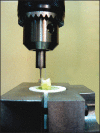Shear bond strength of orthodontic color-change adhesives with different light-curing times
- PMID: 26005468
- PMCID: PMC4432611
Shear bond strength of orthodontic color-change adhesives with different light-curing times
Abstract
Background: The purpose of this study was to evaluate the effect of light-curing time on the shear bond strength (SBS) of two orthodontic color-change adhesives (CCAs).
Materials and methods: A total of 72 extracted premolars were randomly assigned into 6 groups of 12 teeth each. Subsequent to primer application, a metal bracket was bonded to the buccal surface using an orthodontic adhesive. Two CCAs (Greengloo and Transbond Plus) were tested and one conventional light-cured adhesive (Resilience) served as control. For each adhesive, the specimens were light-cured for two different times of 20 and 40 s. All the specimens underwent mechanical testing using a universal testing machine to measure the SBS. Adhesive remnant index (ARI) was used to assess the remnant adhesive material on the tooth surface. All statistical analyses were performed using SPSS software. The significance level for all statistical tests was set at P ≤ 0.05.
Results: The SBSs of the tested groups were in the range of 14.05-31.25 MPa. Greengloo adhesive showed the highest SBS values when light-cured for 40 s, and Transbond Plus adhesive showed the lowest values when light-cured for 20 s. ARI scores of Transbond Plus adhesive were significantly higher than those of controls, while other differences in ARI values were not significant.
Conclusion: Within the limitations of his study, decreasing the light-curing time from 40 to 20 s decreased the SBS of the tested adhesives; however, this decline in SBS was statistically significant only in Transbond Plus adhesive.
Keywords: Adhesive system; bond strength; dental adhesive; light curing; orthodontic bonding; shear bond strength.
Conflict of interest statement
Figures
Similar articles
-
An In-Vitro Comparison of Shear Bond Strength and Adhesive Remnant Score Between Two Color Change Adhesives in Orthodontic Bonding With Reduced Curing Time Using Different High-Intensity Light Emitting Diode Units.Cureus. 2023 Jun 25;15(6):e40951. doi: 10.7759/cureus.40951. eCollection 2023 Jun. Cureus. 2023. PMID: 37503503 Free PMC article.
-
Evaluation of the shear bond strength and adhesive remnant index of color change, fluorescent, and conventional orthodontic adhesives: An in vitro study.Int Orthod. 2023 Mar;21(1):100712. doi: 10.1016/j.ortho.2022.100712. Epub 2022 Dec 6. Int Orthod. 2023. PMID: 36493626
-
Influence of adhesion promoters and curing-light sources on the shear bond strength of orthodontic brackets.Indian J Dent Res. 2012 Nov-Dec;23(6):747-52. doi: 10.4103/0970-9290.111252. Indian J Dent Res. 2012. PMID: 23649057
-
Evaluation of the effect of antimicrobial nanoparticles on bond strength of orthodontic adhesives: A review article.Dent Res J (Isfahan). 2021 Dec 10;18:110. eCollection 2021. Dent Res J (Isfahan). 2021. PMID: 35265293 Free PMC article. Review.
-
Antibacterial Properties and Shear Bond Strength of Titanium Dioxide Nanoparticles Incorporated into an Orthodontic Adhesive: A Systematic Review.Int J Clin Pediatr Dent. 2024 Jan;17(1):102-108. doi: 10.5005/jp-journals-10005-2729. Int J Clin Pediatr Dent. 2024. PMID: 38559855 Free PMC article. Review.
Cited by
-
Clinical performance of light-cured orthodontic adhesives for bonding brackets - an in-vitro study.F1000Res. 2023 Nov 7;12:1442. doi: 10.12688/f1000research.141328.1. eCollection 2023. F1000Res. 2023. PMID: 38264264 Free PMC article.
-
Shear bond strength of ceramic and metal brackets bonded to enamel using color-change adhesive.Dent Res J (Isfahan). 2019 Jul-Aug;16(4):233-238. Dent Res J (Isfahan). 2019. PMID: 31303877 Free PMC article.
-
Effect of Yd:YAG laser irradiation on the shear bond strength of orthodontic metal brackets.Dental Press J Orthod. 2020 Jan-Feb;25(1):28-35. doi: 10.1590/2177-6709.25.1.028-035.oar. Dental Press J Orthod. 2020. PMID: 32215475 Free PMC article.
-
Effect of Different Types of Adhesive Agents on Orthodontic Bracket Shear Bond Strength: A Cyclic Loading Study.Materials (Basel). 2023 Jan 11;16(2):724. doi: 10.3390/ma16020724. Materials (Basel). 2023. PMID: 36676460 Free PMC article.
-
Comparative analysis of shear bond strength and debonding characteristics of bioactive versus conventional orthodontic adhesives: An in-vitro study.Saudi Dent J. 2025 Apr 15;37(1-3):3. doi: 10.1007/s44445-025-00002-5. Saudi Dent J. 2025. PMID: 40397265 Free PMC article.
References
-
- Sunna S, Rock WP. An ex vivo investigation into the bond strength of orthodontic brackets and adhesive systems. Br J Orthod. 1999;26:47–50. - PubMed
-
- Heravi F, Bayani S. Changes in shear bond strength of ceramic and stainless steel brackets with different visible light curing times and directions. Aust Orthod J. 2009;25:153–7. - PubMed
-
- Mavropoulos A, Staudt CB, Kiliaridis S, Krejci I. Light curing time reduction: In vitro evaluation of new intensive light-emitting diode curing units. Eur J Orthod. 2005;27:408–12. - PubMed
-
- Duers MW, English JD, Ontiveros JC, Powers JM, Bussa HI, Frey GN, et al. Bond strength comparison of color change adhesives for orthodontic bonding. Tex Dent J. 2011;128:267–75. - PubMed


